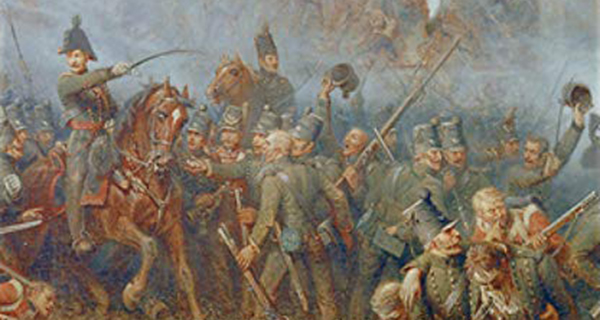 Although I considered myself reasonably well informed about the June 1815 Battle of Waterloo, the critical role of the King’s German Legion (KGL) and La Haye Sainte slipped below my radar.
Although I considered myself reasonably well informed about the June 1815 Battle of Waterloo, the critical role of the King’s German Legion (KGL) and La Haye Sainte slipped below my radar.
That’s been rectified by The Longest Afternoon, a slim volume from historian Brendan Simms.
Simms, born in Dublin and educated at Trinity College, is a Cambridge professor. He’s also a prolific author on the subject of European history and politics.
The KGL was founded in 1803 in response to Napoleon overrunning the northern German state of Hanover. The monarch in question was the United Kingdom’s George III, who also happened to be Elector of Hanover. Thus in pledging loyalty to the king, the Hanoverians were aligning with one of their own against the French invader.
By the time of Waterloo 12 years later, about half of the legion’s rank and file came from non-Hanoverian sources, particularly from other German territories. As Simms tells the story, there were even a few Russians, Danes and Poles.
The British connection went beyond a shared sovereign.
 Organizationally, the KGL was established as part of the regular British army and some of its officer corps were also British. And its base camps were in southern England, at Bexhill-on-Sea for the infantry and Weymouth for the cavalry.
Organizationally, the KGL was established as part of the regular British army and some of its officer corps were also British. And its base camps were in southern England, at Bexhill-on-Sea for the infantry and Weymouth for the cavalry.
The KGL unit in action at La Haye Sainte was the 2nd Light Battalion, commanded on the day by Maj. Georg Baring.
Baring joined the army of his native Hanover at the age of 14 in 1787 and was subsequently one of the KGL’s founding members. He fought against Napoleon from the Baltic to the Iberian Peninsula. By June 1815, he was a battle-hardened veteran accustomed to the rigours of command. As events transpired, that was a very good thing.
The Duke of Wellington’s decision to engage Napoleon at Waterloo was contingent on the understanding that Field Marshal Gebhard Leberecht von Blucher’s Prussian army would join him for the fray. However, there was the matter of time. Blucher was some distance away.
This was where La Haye Sainte became critical.
Strategically located between the centre of Wellington’s army and Napoleon’s oncoming forces, the farmhouse’s defenders were tasked with helping to buy time. Delay Napoleon for as long as possible so Blucher would arrive to tip the balance.
Baring had 378 men at his disposal for this assignment. Unfortunately, they were a tad short on ammunition, having no more than 60 rounds apiece.
The engagement began in the early afternoon of June 15 and extended for almost five hours. The French attacks came in waves and Baring’s men were periodically reinforced but always outnumbered. Running out of ammunition, they eventually abandoned the farmhouse.
The mission, however, was accomplished. As Simms puts it, “the defenders held out for nearly five crucial hours while Napoleon’s clock ticked.”
Thanks to this breathing space, Wellington’s centre held, Blucher arrived, thousands of Prussians poured into the field and Napoleon’s army was defeated. The KGL’s 2nd Light Battalion left its mark on European history.
Simms attributes this remarkable performance to three things.
One was patriotic. Formed in opposition to Napoleon’s invasion of Hanover, many of the KGL’s members saw themselves as fighting for king and country. George III didn’t just belong to the United Kingdom, he was theirs also.
Another was the military concept of honour. Instead of shirking, you did your duty.
Finally, Simms suggests that this level of bonding depended on “an unspoken uncontract between officers and men that lives would not be needlessly sacrificed. There was always a moment when withdrawal or surrender became appropriate and honourable.” Rather than glorifying in blood sacrifice, the “heroism of the garrison of La Haye Sainte was rational, not suicidal; they fought to the last bullet, but not to the last man.”
Simms also touches on the question of whether Waterloo should be seen as primarily a German, rather than a British, victory.
Of Wellington’s army that day, only 36 per cent were British – defined as English, Irish, Welsh and Scottish. Counting the KGL, some 45 per cent came from various German states and a combination of Dutch and Belgians made up the balance.
And that’s just the army Wellington started with. When you add in Blucher’s late-arriving Prussians, the force that vanquished Napoleon takes on a predominantly Germanic complexion.
In retrospect, the era of German ascendance was at hand.
Troy Media columnist Pat Murphy casts a history buff’s eye at the goings-on in our world. Never cynical – well, perhaps just a little bit.
The views, opinions and positions expressed by columnists and contributors are the author’s alone. They do not inherently or expressly reflect the views, opinions and/or positions of our publication.


